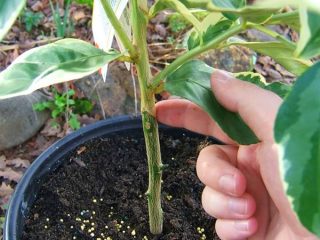Content
Propagating lemons by cuttings at home is a less common procedure among beginners than planting seeds. But it is this method that makes it possible to grow a full-fledged plant capable of bearing fruit.
The technique has its own nuances, which it is advisable to find out before cuttings begin. The procedure allows you to grow a fruit-bearing tree at home or use the plant for grafting.
Is it possible to propagate a lemon from a twig?
Lemons can be propagated in two ways - planting a seed and rooting a cutting. A twig is a faster option that is not suitable for all citrus fruits. However, lemon propagates well by cuttings, blooms and bears fruit well under favorable growing conditions. Planting lemons at home using cuttings is a more popular option due to its effectiveness.
Benefits of propagating lemon from cuttings
If we consider both methods of planting lemons, we should highlight the advantages of cuttings. This will allow gardeners to decide which propagation method to choose:
- Although a plant grown from seed will be stronger and more active in growth, it will not be able to retain all the varietal characteristics. Propagation by cuttings guarantees 100% preservation of the genetic parent material. This is very important when propagating a variety you like with quality characteristics.
- Another important benefit is the beginning of lemon fruiting. With the seed method, the first fruits will appear in 8-10 years. Cuttings reduce this period by half.
- Financial savings are the next advantage compared to purchasing ready-made seedlings. Harvesting cuttings will cost much less than buying an adult lemon at a garden market.
- Cuttings make it possible to graft plants. You can cut branches from wild lemons and plant the desired variety. Wild plants take root more easily, they are hardier and more stable than cultivated species.
Considering the listed advantages, gardeners grow lemon from cuttings much more often than other methods.
How to grow a lemon from a cutting
To get a healthy, strong plant, you need to perform certain actions, as well as comply with the conditions for growing lemon from cuttings at home:
- prepare cuttings at the appropriate time;
- root lemon sprigs;
- transplant to a permanent place;
- provide cuttings with quality care.
With good care, the tree will bear fruit for a long time and regularly. Before starting the procedure, you must familiarize yourself with the description, steps and rules for performing each action. It is useful to read reviews from those who have already propagated lemons at home using cuttings.
Harvesting cuttings
This is a very important stage. The amount of planting material and its development depend on the quality of the workpieces.The first requirement is to choose a strong, healthy plant that is 3-4 years old.
Lemon branches are cut from last year's growth. In this case, lignified shoots with green bark are selected. The optimal harvesting time is March or April, although it is allowed throughout the growing season. You can root the branch after trimming the lemon.
The cut is made slightly obliquely and is immediately treated with garden varnish. The top cut can be left straight. Before cutting a lemon, the tool must be disinfected and sharpened. Usually a stationery knife or garden shears is used.
A properly prepared lemon cutting should have 2-3 leaves and 3-4 formed buds. The distance between the ends of the sections and the outer buds is about 0.5 cm. The length of the shank is 8-10 cm, thickness is 4-5 mm.
The leaves on the lemon cuttings must be trimmed to facilitate root development. The smallest top ones can be left untouched, the rest can be shortened by a third, the larger ones by half.
Tie the prepared branches and place them in a solution of Heteroauxin (take 0.1 g of substance per 1 liter of water) or potassium permanganate for 24 hours. Then dip the lower cut of the cutting in crushed charcoal and you can move on to the next stage - rooting.
How to root a lemon at home
To successfully root a lemon, you will need to prepare a planting container, soil, and create conditions for the cutting to take root. In addition to the usual method of rooting lemon cuttings in the ground, propagation by layering is used. They are also rooted before being separated from the parent plant.
There are other ways to plant a lemon shoot - a greenhouse with peat or peat tablets.The first gives quite successful results, the second has not yet received proper distribution.
It is also easy to root a lemon in water. To do this, some conditions must be met:
- Constantly maintain the water temperature at least + 23-25 °C.
- Place the lemon stalk in an opaque container.
- The volume of the container should be small, even a little tight for the plant.
- It is necessary to immerse only the very tip of the cutting - up to 2 cm.
- Cover the dish with the cuttings with film or a jar.
There is a useful trick for those who want to use a similar method. The lower cut of the cutting is wrapped in cotton material, and the end of the fabric is dipped into water. The cuttings receive enough water and air, take root well and develop. After strong roots appear, the plant is transplanted into the ground.
How to plant a lemon cutting
It is quite possible to plant a lemon cutting at home. First, you need to prepare the chubuchas, choosing the optimal time and a suitable plant for cutting them. Then prepare containers and components for the soil mixture, materials for building a greenhouse. To create optimal conditions, it is necessary to take care of sufficient lighting, humidity and temperature at which the cuttings will take root. Greenhouse conditions allow the branches to quickly adapt and take root. It is important not to overdo it with humidity. The slightest violation of conditions will cause rotting of the planting material.
Preparing containers and soil
When choosing containers, the main attention is paid to the diameter of the pot. Cuttings do not need a large volume in which the soil can become sour.
In order for a powerful root system to develop, it is necessary to prepare a nutrient mixture for the cuttings.Gardeners use different combinations, but the main components are clean sand, humus or compost. An important point is the presence of a drainage layer to allow excess moisture to escape. Some people prefer to buy ready-made soil for citrus fruits, but it is more suitable at the time of transplanting the cutting to a permanent place.
The prepared container is disinfected. The flower pot is thoroughly washed with a disinfecting solution and dried. The box is burned from the inside.
Then the layers are laid. The first is drainage. Small stone, expanded clay and charcoal are suitable for it. The second layer should be nutritious. It is the highest and should be 2/3 of the height of the container. A small depression is made in it. When the roots develop, the lemon will immediately receive the necessary substances. The top layer is made of clean sand 2 cm thick. It must be washed with water several times so that the flowing water does not contain dirt impurities. Some gardeners mix sand with sphagnum moss or peat in equal parts. This technique allows the cutting to hold more firmly and retain moisture. The total height of the layers depends on the size of the planting container.
Planting lemon cuttings
The planting technology is clear and not difficult to implement. To propagate indoor lemon from cuttings, you need to follow certain steps.
First, the soil in the container is moistened, the branches are buried to the level of the second eye, and the soil is slightly pressed around the stem. Then spray the plant with warm water from a spray bottle.
All that remains is to create greenhouse conditions for the cuttings. The container is covered with a glass cap or jar or polyethylene.Every day the greenhouse is opened for 10 minutes for ventilation and spraying (3-4 times a day until rooting). If large condensation is noticed on the film, the frequency of irrigation should be reduced to prevent mold from appearing.
The ambient temperature should be + 20-25 °C. If artificial heating is not possible, some gardeners use biological heating. To do this, place a layer of manure in a bucket, then place a pot with a cutting and cover it with film.
Lighting should be sufficient, but without direct sunlight. In darkened rooms, additional lighting is used.
Video about propagating lemon by cuttings at home:
Rooting time is usually 3-4 weeks. If the cutting produces buds, they are removed. When the cuttings take root, they begin to accustom them to the air. The greenhouse is opened daily for 1 hour, increasing the hardening time for 1-2 weeks. The container can then be opened completely. After 7 days, the rooted plant is transplanted into a pot with a diameter of 9-10 cm, filled with a constant nutrient mixture. During this time, the lemon adapts to the ambient temperature and will tolerate transplantation well.
When transplanting a cutting, be sure to lay a drainage layer, then 1 cm of coarse river sand, and 2 cm of nutritious soil mixture on top. The rooted cutting is removed from the nursery along with a lump of earth and placed in a new pot. The root collar is not buried. Then the container is transferred to a shaded place for 10 days, gradually increasing the lighting.
These are the basic requirements, the fulfillment of which will allow you to grow a fruit-bearing lemon from a cutting at home.
How to plant a lemon shoot without roots
In this case, it is important to create all the conditions for the formation of roots. To plant and grow a lemon from a twig, you need to provide:
- Constant air humidity, for which the shoot is covered with a dome.
- Nutrient substrate for root growth.
- Illumination is of medium intensity, preferably partial shade.
- Regular ventilation.
- Spraying with warm water 2-3 times a day.
If the branch has large leaves, they need to be cut in half. Small ones can be left in their original form.
How to grow a lemon from a twig
After transplanting a rooted cutting, it needs to be properly cared for. Otherwise, the development of the lemon will be very long. Be sure to prepare a place for the plant. Lemon does not like unnecessary movements, so you need to take care of this in advance. The optimal location is the south side of the room. To ensure that the crown is formed evenly, the tree can be rotated, but at a small angle and gradually. It is important that the lemon has time to turn its leaves.
Points that require attention:
- Soil composition. It should have enough nutritional components. It is recommended to take a ready-made mixture for citrus fruits or prepare it yourself. Garden soil with humus in a 1:1 ratio is suitable. A drainage layer is placed at the bottom of the pot to avoid moisture stagnation.
- It is best to use a clay container for the plant. Good moisture permeability of clay allows you to balance the moisture of the earth.
- It is enough to water 2 times a week. At the same time, you should ensure that the soil does not dry out. In this case, the roots will dry out and the plant will become sick.Overmoistening is also harmful, as it will lead to rotting of the root system. The required percentage of humidity is maintained by spraying the crown 2-3 times a week. When the heating season begins, the procedure is done daily.Important! If there is an overflow and the soil begins to rot, then a complete replacement of the soil is required.
- Lemon loves lighting. But direct sunlight should not hit the tree for more than 2 hours a day. You should choose a place where the plant will not be illuminated by the sun throughout the day.
- Comfortable temperature for lemon at home is + 18-27 °C. It should be remembered that drafts are very harmful to the plant. Lemon pots should be placed in a protected place.
- Feeding is needed throughout the warm season - from the beginning of spring until autumn. It is best to use special formulations for citrus fruits, which are sold in specialized stores. In this case, organic and mineral fertilizers must be alternated.
- Replantation is carried out every year. As the plants grow, take a pot 1-2 cm larger than before. At the same time, it is important not to damage the root system, so carefully remove the lemon with a lump of earth, then add a new one to the required volume. When the pot size reaches 8-10 liters, replanting is replaced by fertilizing and updating the top layer of soil twice a year.
- Crown formation and pruning are necessary to give the lemon an aesthetic appearance and ensure harmonious development. The central shoot is pruned for the first time in the spring in the second year of the tree’s life. You need to shorten it to 20 cm. Thanks to this, the seedling will send out lateral shoots. Then the lower buds are removed, leaving only the 3 upper ones. The next year they repeat the same procedure, but with side branches.When the tree takes a beautiful shape, it will be enough to pinch or remove fast-growing shoots.
- Lemon grown at home begins to bloom after 3-4 years. At this point, you need to pollinate using a cotton swab. When there are a lot of fruits set, it is recommended to remove some of them. Otherwise, the lemon will become depleted and may die. The normal proportion is one fruit per 10-15 leaves.
When you need to transport the tree to another place, it is better not to do this in winter. Lemon is very responsive to changes in air temperature.
Growing lemons at home using cuttings is a very popular method. There are few basic care requirements. If you do them regularly, then after a few years you can taste your own lemons.
Conclusion
Propagating lemons by cuttings at home is a completely doable task. Not only an experienced gardener, but also a novice gardener can handle it. The main thing is to be attentive to the plant and carry out the necessary procedures on time.














